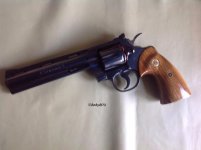xfarfuldog
Member
I am a retired police officer. I started out with a model 19 Smith and quali quickly changed to a 4" Python. My department eventually changed to autos and I carried a Sig. I am now 66 and will probably work until I am 70. I work for an armored car company and carry a 40 M&P.
I am starting to get arthritis in my hands and the 40 hurts to shoot. We will be changing to a 9 mm soon. I have a Sig, Beretta, Glocks, and a Shield in autos. I also have my original Python and a no dash and dash 1 686's.
I like shooting the Python the best. The 686's are fine. It not as good as the Python. As I get older I think I will have trouble with the slides on the autos. I may reduce my collection to 1 gun. If I keep and use the Python, will it hold up? I have owned it for over 30 years, only go shooting once a month and generally shoot 38 special.
I am starting to get arthritis in my hands and the 40 hurts to shoot. We will be changing to a 9 mm soon. I have a Sig, Beretta, Glocks, and a Shield in autos. I also have my original Python and a no dash and dash 1 686's.
I like shooting the Python the best. The 686's are fine. It not as good as the Python. As I get older I think I will have trouble with the slides on the autos. I may reduce my collection to 1 gun. If I keep and use the Python, will it hold up? I have owned it for over 30 years, only go shooting once a month and generally shoot 38 special.




